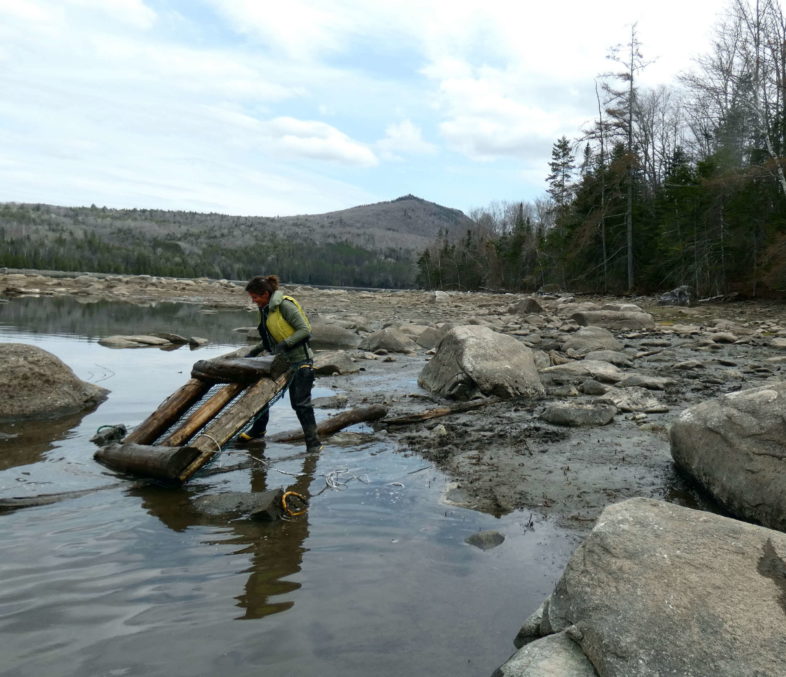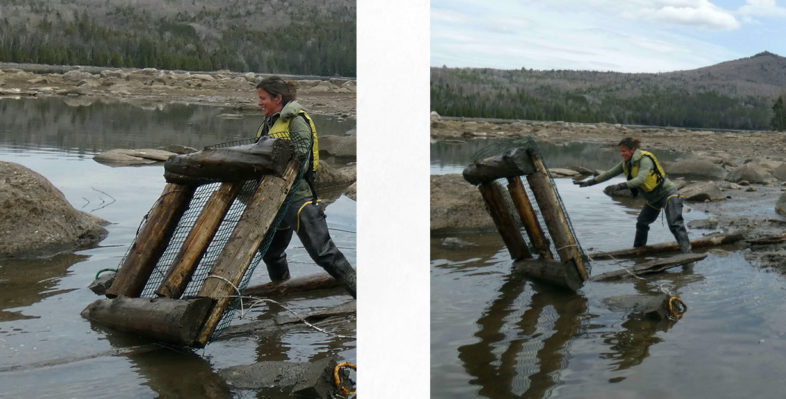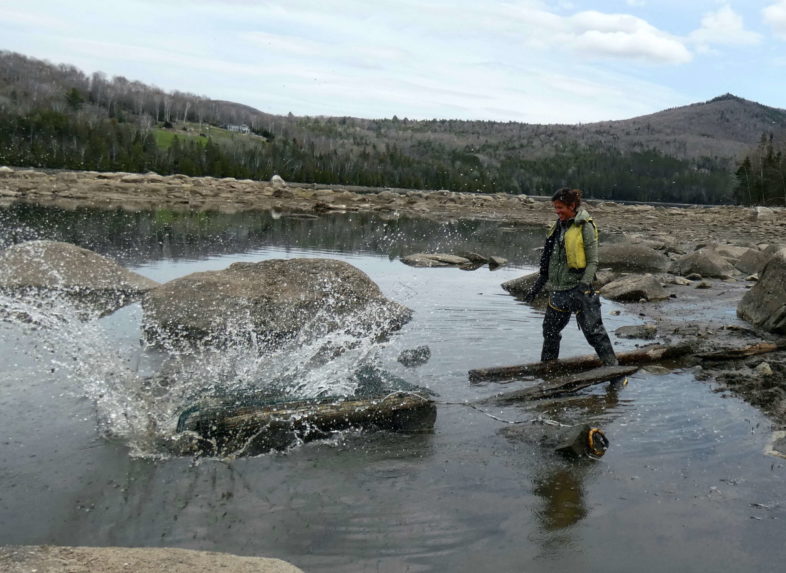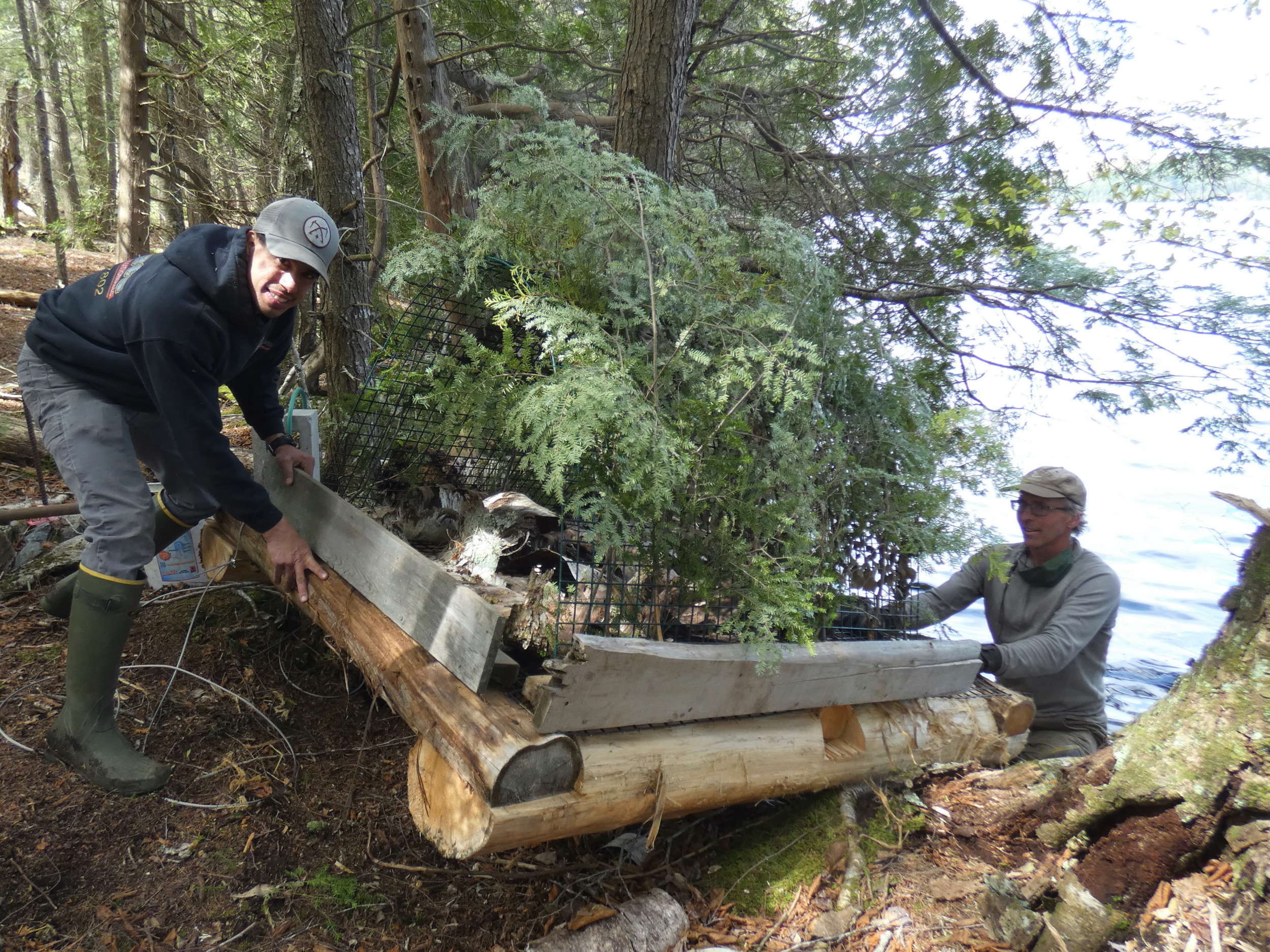
After 100 feet of difficult maneuvering, seasonal biologist Eloise Girard makes the final flip of a raft on Molly’s Falls Reservoir. Photo by Eric Hanson.
For many Vermonters, late April and early May means that ice has finally receded from lakes and ponds and that it’s time to put paddles to water. For seasonal biologist Eloise Girard and I, as well as 20 dedicated volunteers, this time of year signifies something different: “nesting raft season” has begun!
Nesting raft season marks an important first step in supporting Vermont loons throughout their breeding season. We leave most rafts in the water year-round as it usually makes them easier to prepare come springtime. Shrubs and grasses on many rafts survive the winter and are already green or close to leaf out in May. We often plant additional bare-root shrubs and small conifers for cover and add a little nest bowl material to give the loons some fresh grasses, moss, and dirt to work with. Sometimes we find that muskrats, beavers, and geese have made a mess of any vegetation leftover from the previous year. The damage we see can range from eating every available shrub to burrowing into nest bowls for a winter den. Ice can also clear off entire rafts and twist up the cables and cement blocks holding them in place. Some of these problems require repairs a bit more extensive than replanting, however they’re important for getting rafts loon-ready. Luckily, nest bowls are usually intact. In some cases, the early-to-business loons beat us to the raft and start nesting. On May 4, Eloise found a loon incubating on No. 10 Pond’s raft in Calais before we could give it our housekeeping makeover.

Lift!! Almost there… Photo by Eric Hanson.

Success! Now to add the shrubs and grasses. Photo by Eric Hanson.
A recent nesting raft expedition took us to Molly’s Falls Reservoir. Upon arriving, we discovered that Green Mountain Power is making major dam repairs for the second year in a row. Last year, we built new rafts rather than try to haul all dry-docked ones 50-100 feet down the mudflats. This year, the water was even lower. We decided to try to move the raft pictured above across the 6–12-inch deep goop that used to be lake bottom. Eloise and I flipped it end-over-end for 100 plus feet onto logs we continually moved ahead. This photo series shows us finally reaching the water’s edge. I apologized to Eloise after; this level of effort had not been included in the job description. Needless to say, she valiantly rose to the occasion!

LoonWatch volunteer Barb Ward pauses for a quick selfie while hauling out numerous nest warning signs and cement blocks on Kent Pond. Photo by Barb Ward.
Eloise and I are not the only ones hard at work—volunteers play a key role in ensuring proper management of signs and rafts. LoonWatch volunteer Barb Ward recently discovered a loon nest on Kent Pond. These loons appear to have chosen a new nest site because a pair of geese moved in next door to the loons’ past site. I told Barb I would put the loon nest warning signs out within a week, but she offered to try to put the seven signs out using her kayak—not an easy task. Thankfully, she got the signs up just before weekend boating activity increased. Thank you, Barb! (UPDATE – the Kent Pond pair had one chick this past week.)
We also had a new set of hands helping us this spring. VCE’s Director of Conservation Science, Ryan Rebozo, joined us for a day and helped fix two older rafts on Ricker and Kettle ponds. We even built a new raft for the south end of Harvey’s Lake where a new loon pair has yet to successfully nest. Welcome to the management side of conservation work, Ryan.

Ryan Rebozo (left) and Eric Hanson (right) slide a new nesting raft into Harvey’s Lake. Photo by Eloise Girard.
At this time, many loons have started nesting. A handful of pairs began ahead of schedule due to early ice-out this year, however, most pairs start nesting between May 20 and June 15. Now that “nesting raft season” is winding to a close, I’ll be back soon with a report on new pairs, nesting and chick updates, and any interesting stories from Vermont’s loon world.

Thank you, Eric, for all you do to help our loon population & to inform the public. I always look forward to your communications. Thanks, too, to all the rest of the staff & to your volunteers.
It is wonderful how successful the loon story in Vermont is, thanks to the efforts of so many. Always a thrill to hear and/or see loons. Such beautiful, interesting creatures.
The loons are very fortunate to have you all working so hard for them.
Judy Lance Winooski
Hi there,
Great article. Are there any floating nest sites at the Waterbury Reservoir? We’ve had pairs (and more) of adult loons for the last handful of years, but I’ve never seen babies. I’m thinking the rising and falling (dam) water levels might be flooding nesting sites.
Hi Tom, Yes, there has been a raft at the north end of Waterbury Res.for 2 years now but the loons have yet to choose it. In some locations, the loons go right to the raft as good “island-like” habitat; other pairs keep using less ideal sites like shoreline. The north pair was obsered nest building near the location of the 2019 failed nest. The ranger moved the raft close by in hopes they’ll choose that site since we know the reservoir goes up quickly with any substantial rainfall. I’ve had reports of a twosome in the south end, but only twice, thus more surveys in that area would help confirm if a new pair is forming or if it’s just two loons together for a short time. Seeing a twosome for 2 months consistently is the best indication of pair formation. Eric Hanson